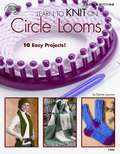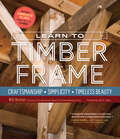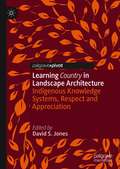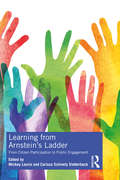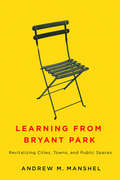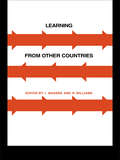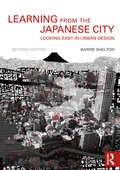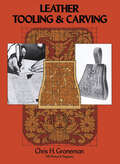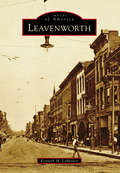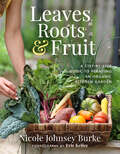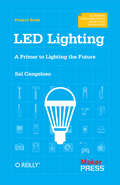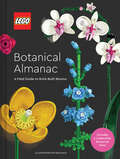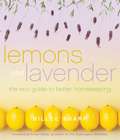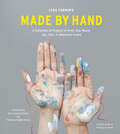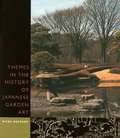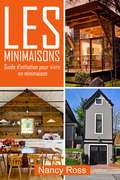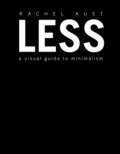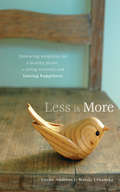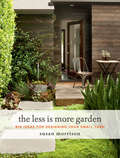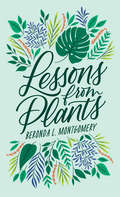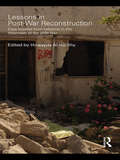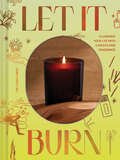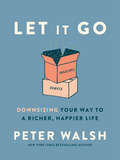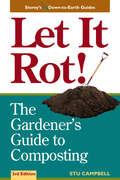- Table View
- List View
Learn to Knit on Circle Looms (Loom Knitting)
by Denise Layman10 fun and easy patterns plus instructions and techniques for beginners of the knitting looms.
Learn to Timber Frame: Craftsmanship, Simplicity, Timeless Beauty
by Jack A. Sobon Will BeemerThe first guide to timber framing written specifically for beginners! Expert Will Beemer takes you through the entire process from start to finish, beginning with timber sourcing and ending with a finished building. Using full-color photos, detailed drawings, and clear step-by-step instructions, Beemer shows you exactly how to build one small (12ʹ x 16ʹ) timber-frame structure — suitable for use as a cabin, workshop, or studio. He also explains how to modify the structure to suit your needs and location by adding a loft, moving doors or windows, changing the roof pitch, or making the frame larger or smaller. You’ll end up with a beautiful building as well as solid timber-framing skills that you can use for a lifetime.
Learning Country in Landscape Architecture: Indigenous Knowledge Systems, Respect and Appreciation
by David S. JonesThis book strategically focuses upon the feasibility of positioning Indigenous Knowledge Systems into tertiary built environment education and research in Australia. Australian tertiary education has little engaged with Indigenous peoples and their Indigenous Knowledge Systems, and the respectful translation of their Indigenous Knowledge Systems into tertiary education learning. In contrast, while there has been a dearth of discussion and research on this topic pertaining to the tertiary sector, the secondary school sector has passionately pursued this topic. There is an uneasiness by the tertiary sector to engage in this realm, overwhelmed already by the imperatives of the Commonwealth’s ‘Closing the Gap’ initiative to advance Aboriginal and Torres Strait Islander tertiary education successes and appointments of Indigenous academics. As a consequence, the teaching of Indigenous Knowledge Systems relevant to professional disciplines, particularly landscape architecture where it is most apt, is overlooked and similarly little addressed in the relevant professional institute education accreditation standards.
Learning from Arnstein's Ladder: From Citizen Participation to Public Engagement
by Mickey Lauria and Carissa Schively SlotterbackSherry Arnstein, writing in 1969 about citizen involvement in planning processes in the United States, described a “ladder of citizen participation” that showed participation ranging from low to high. Arnstein depicted the failings of typical participation processes at the time and characterized aspirations toward engagement that have now been elevated to core values in planning practice. But since that time, the political, economic, and social context has evolved greatly, and planners, organizers, and residents have been involved in planning and community development practice in ways previously unforeseen. Learning from Arnstein’s Ladder draws on contemporary theory, expertise, empirical analysis, and practical applications in what is now more commonly termed public engagement in planning to examine the enduring impacts of Arnstein’s work and the pervasive challenges that planners face in advancing meaningful public engagement. This book presents research from throughout the world, including Australia, Brazil, India, Indonesia, Portugal, Serbia, and the United States, among others, that utilizes, critiques, revises, and expands upon Arnstein’s aspirational vision. It is essential reading for educators and students of planning.
Learning from Bryant Park: Revitalizing Cities, Towns, and Public Spaces
by Andrew M. ManshelBy the 1970s, 42nd Street in New York was widely perceived to be unsafe, a neighborhood thought to be populated largely by drug dealers, porn shops, and muggers. But in 1979, civic leaders developed a long-term vision for revitalizing one especially blighted block, Bryant Park. The reopening of the park in the 1990s helped inject new vitality into midtown Manhattan and served as a model for many other downtown revitalization projects. So what about urban policy can we learn from Bryant Park? In this new book, Andrew M. Manshel draws from both urbanist theory and his first-hand experiences as a urban public space developer and manager who worked on Bryant Park and later applied its strategies to an equally successful redevelopment project in a very different New York neighborhood: Jamaica, Queens. He candidly describes what does (and doesn’t) work when coordinating urban redevelopment projects, giving special attention to each of the many details that must be carefully observed and balanced, from encouraging economic development to fostering creative communities to delivering appropriate services to the homeless. Learning from Bryant Park is thus essential reading for anyone who cares about giving new energy to downtowns and public spaces.
Learning from Other Countries: The Cross-National Dimension in Urban Policy Making
by Ian Masser and Richard WilliamsLooking at the lessons we can learn from international research in urban and regional planning, this book explores the challenges in using cross-country studies. The contributors address how to approach researching planning in other countries, and how to then diffuse the planning information. Key topics include: comparable urban data, and how to use it working with international agencies methodological issues in cross-country research translating theory into practice Case studies include researching new towns in France and Poland, and problems doing empirical work in Eastern Europe.
Learning from the Japanese City: Looking East in Urban Design (Planning, History and Environment Series)
by Barrie SheltonJapanese cities are amongst the most intriguing and confounding anywhere. Their structures, patterns of building and broader visual characteristics defy conventional urban design theories, and the book explores why this is so. Like its cities, Japan’s written language is recognized as one of the most complicated, and the book is unique in revealing how the two are closely related. Set perceptively against a sweep of ideas drawn from history, geography, science, cultural and design theory, Learning from the Japanese City is a highly original exploration of contemporary urbanism that crosses disciplines, scales, time and space. This is a thoroughly revised and much extended version of a book that drew extensive praise in its first edition. Most parts have stood the test of time and remain. A few are replaced or removed; about a hundred figures appear for the first time. Most important is an entirely new (sixth) section. This brings together many of the urban characteristics, otherwise encountered in fragments through the book, in one walkable district of what is arguably Japan’s most convenient metropolis, Nagoya. The interplay between culture, built form and cities remains at the heart of this highly readable book, while a change in subtitle to Looking East in Urban Design reflects increased emphasis on real places and design implications.
Leather Tooling and Carving
by Chris H. GronemanThis book by a well-known handicrafts instructor will teach you the fine art of leather tooling and carving so that you will now be able to make the handsomely crafted leather of handbags, belts, watchbands, and billfolds you have often admired. You will find that custom-crafted leather items are not only easier to make than you may have expected but also offer quite an enjoyable hobby.Many books deal with leatherwork in general but this book is one of the few that concentrate on tooling and carving. The author first introduces the various types of leather and tools, giving complete information on how to identify the superior sections of a hide and how to decide on which kind of leather is best for your purpose: kidskin for gloves, steerhide for billfolds, etc. Twenty-six different leather tools are depicted along with an illustration of the impressions the different kinds of stamping tools make. After this necessary background, the author covers the basic processes of leather crafting from start to finish: cutting and preparing the leather, transferring the design, tooling, carving, lacing, cleaning, dyeing, and finishing. This section is profusely illustrated with line drawings and photographs to make each step easy to master. You are now ready to begin the special projects, for which complete instructions and patterns are provided: bookmarks, key cases, coin purses, watchbands, billfolds, belts, shaving kits, camera bags, handbags, and cowboy accessories are just a few of the things you will be able to make.Hand-tooled leather items are quite expensive on the market, but you will find yourself with substantial savings when you make them yourself. What is more important, however, is that leather tooling and carving is an enjoyable craft that anyone can become adept at -- and this book will provide you with all you need to do just that.
Leavenworth
by Kenneth M. LamasterOn May 30, 1854, Pres. Franklin Pierce signed the hotly contested Kansas-Nebraska Act. Before the ink was dry, squatters settled on the 322-acre plot of land bounded by the Fort Leavenworth Military Reservation (to the north) and Three Mile Creek (to the south). From Bleeding Kansas to western expansion, many historical figures have called Leavenworth home, including Fred Harvey, Buffalo Bill Cody, and Wild Bill Hickok, to name but a few. The landscape is decorated with buildings and homes featuring a beauty and grandeur that have stood the test of time. Originally known as the �Queen City of the West,� this metropolis would become one of the largest manufacturing cities in America, providing goods and services to markets all over the world. Historical churches, the Leavenworth VA Medical Center, the Sisters of Charity of Leavenworth, and Leavenworth National Cemetery all contribute to the town�s pioneering spirit that is second to none.
Leaves, Roots & Fruit: A Step-by-Step Guide to Planting an Organic Kitchen Garden
by Nicole Johnsey BurkeAn Intuitive Gardening System Built for SuccessDo you dream of walking through your own kitchen garden with baskets full of delicious food you grew yourself? But are you waiting to begin because you think you don&’t have enough space, sun, time, or experience?Then consider this: Plants want to grow. And when you match a plant&’s needs to your own resources, you&’re just one step away from success in the kitchen garden.Nicole Johnsey Burke—founder of Gardenary, Inc., and author of Kitchen Garden Revival—is your expert guide for growing your own fresh, organic food every day of the year, no matter where you grow. More than just providing the how-to, she gives you the know-how for a practical and intuitive gardening system that includes:- Leaves – quick satisfaction from abundant harvests, most available and simplest to grow; includes salad greens and herbs- Roots – underground harvests that require more tending and are built for endurance, longevity, and longer shelf life; includes tubers, bulbs, and rhizomes- Fruit – the most demanding and sweetest of all, requiring the most space, sunlight, and consistent watering to blossom; includes beans, squash, and tomatoesBurke provides clear step-by-step instructions for setup, care, and harvest for each category of plants, complete with insightful tips for every level of gardener to grow with their plants.There&’s always a plant you can grow right where you are, right away—all you have to do is follow the steps.
LED Lighting
by Sal CangelosoWe're on the brink of a lighting revolution with light-emitting diodes--the tiny LEDs you've seen in electronic devices for years. With this practical guide, you'll go behind the scenes to see how and why manufacturers are now designing LED devices to light everything from homes and offices to streets and warehouses. Author Sal Cangeloso shows you the working parts of a "simple" LED bulb and explains the challenges electronics companies face as they push LED lighting into the mainstream. You'll learn how you can use LEDs now, and why solid state lighting will bring dramatic changes in the near future. Explore the drivers, phosphors, and integrated circuits in a typical LED bulb Understand the challenges in producing LED bulbs with acceptable brightness, color temperature, and power consumption Learn about non-bulb LED applications, including lamps, street lights, and signage Discover the market forces driving--and impeding--the adoption of LED lighting Compare LEDs to compact fluorescent lamps (CFLs) and electron-stimulated luminescence (ESL) bulbs Gaze into the future of intelligent lighting, including networked lighting systems
LEGO Botanical Almanac: A Field Guide to Brick-Built Blooms
by LEGOBotany in bricks! Take a closer look: This intricately illustrated compendium of flowers and plants has a LEGO® twist—the blooms are built of bricks! Inspired by the bestselling LEGO Botanical sets, this almanac combines floral facts, hand-drawn botanical illustrations, and exclusive stories from the LEGO set designers themselves, plus a bonus removable flower print to display.Inspired by scientific drawings of flora, the beauty is in the details of the singular LEGO® Botanical Almanac. Each page presents a deeper look into a stunning LEGO bloom, succulent, or plant—from garden varietals to the exquisitely exotic. Like traditional botany illustrations, these LEGO flowers are presented as stunning works of art and detailed dissections of real species. Dip in and out to learn about each plant and discover behind-the-scenes details of how LEGO set designers turned iconic bricks into captivating natural forms. A perfect gift for LEGO fans and unlike any other book before it, the LEGO® Botanical Almanac highlights where art meets science and building meets play—a true celebration of the boundless creativity of the LEGO brand.LEGO, the LEGO logo, and the Brick and Knob configurations are trademarks of the LEGO Group. ©2024 The LEGO Group. All rights reserved.EXCLUSIVE REMOVABLE PRINT INCLUDED: Tucked in the back of the book is a removable print featuring a hand-drawn illustration from the book. Frame and hang it on your wall to admire—and spark your creative thinking—every day. UNIQUE FAN ARTIFACT: With beautifully rendered art and a sophisticated package that mimics a true scientific work, this almanac is an unexpected gift for the LEGO fan that has everything. Share the LEGO fandom with this surprisingly beautiful keepsake. A BRAND YOU LOVE AND TRUST: For decades, the LEGO brand has inspired billions of people to stretch the limits of their imaginations and explore the power of play. Discover a new side of the LEGO universe with this beautiful LEGO book.EXCLUSIVES FROM THE LEGO DESIGNERS: The book features behind-the-scenes interviews, stories, and fun facts, offering a unique window into the creative process of developing a LEGO set.Perfect for:LEGO fansLEGO builders who purchased the LEGO Botanical setsGardeners and fresh-cut flower loversPeople interested in home décor and looking for a beautiful flower book to displayPeople fascinated by scientific botanical drawingsMother’s Day, housewarming, anniversary, birthday, Valentine’s Day, or Galentine’s Day gifting
Lemons and Lavender: The Eco Guide to Better Homekeeping
by Billee SharpAuthor Billee Sharp shares her freecycling, budget-savvy, barter-better wisdom in this step-by-step handbook for revolutionizing spending habits and reclaiming quality of life. Lemons and Lavender is an inspiring and instructive guide to living the handmade life by consuming less and creating more. Practical and profound, this handy how-to covers every area of life and offers easy-to-do tips, recipes, and advice for saving money and the planet. Learn how to ditch your lawn and raise organic vegetables, cook healthy meals for pennies, cure minor maladies from the kitchen cabinet, save big dollars with small repairs, and eco-clean your house with lemons and lavender. With this guide, families can live more joyfully and far more creatively, all on a dime.
Lemons and Lavender
by Billee Sharp Anneli RufusAuthor Billee Sharp shares her freecycling, budget-savvy, barter-better wisdom in this step-by-step handbook for revolutionizing spending habits and reclaiming quality of life. Lemons and Lavender is an inspiring and instructive guide to living the handmade life by consuming less and creating more. Practical and profound, this handy how-to covers every area of life and offers easy-to-do tips, recipes, and advice for saving money and the planet. Learn how to ditch your lawn and raise organic vegetables, cook healthy meals for pennies, cure minor maladies from the kitchen cabinet, save big dollars with small repairs, and eco-clean your house with lemons and lavender. With this guide, families can live more joyfully and far more creatively, all on a dime.
Lena Corwin's Made by Hand: A Collection of Projects to Print, Sew, Weave, Dye, Knit, or Otherwise Create
by Lena Corwin“Opens up possibilities for dozens of skills, from printing to origami, from soap-making to patchwork; tie-dying, weaving, embroidery, and more.” —Foreword ReviewsIn 2009, tastemaker and bestselling author Lena Corwin turned the top floor of her Brooklyn brownstone into a studio and began hosting classes for local crafters. In Lena Corwin’s Made by Hand, she recreates and builds upon her popular workshop series in order to reach crafters in Brooklyn and beyond. For this “best of” collection, she has chosen expert teachers and her favorite projects: Jenny Gordy introduces us to knitted socks and elegantly sewn tops and dresses; Cal Patch teaches how to make a modern embroidery sampler as well as a braided rag rug; and Corwin herself presents her favorite screen-printing and stamping techniques. There are many lessons/projects, all presented with step-by-step photos and illustrations. Notice: For usability reasons, the digital edition of this book does not include all of the images found in the physical edition.“Made by Hand introduces readers to ageless crafting techniques with modern projects.” —HGTV.com“Like a private studio class . . . this book is a breath of fresh air.” —Examiner.com“A must-have for anyone who wants to create unique décor.” —Decorating Shortcuts“The 385 detailed illustrations, along with excellent step-by-step photographs and clear instructions, make each project tempting and approachable.” —Studios magazine“Those messy hands alone are inspiring me to get creative.” —Modern Eve“I got a sneak peek at a mostly lovely book. I can’t contain my excitement over this book. The projects are varied and so much fun.” —The Stylish Nest
Leper Priest of Moloka'i: The Father Damien Story
by Richard StewartIn May 1873, Father Damien De Veuster voluntarily became the first resident clergyman and part-time physician for the leper colony on Moloka'i's remote Kalaupapa peninsula. This volume traces the life of Father Damien from his boyhood in rural Belgium to his death at Kalaupapa after sixteen years of remarkable accomplishments. It analyzes much new information about Damien and his years in Hawai'i, giving a fuller understanding of the extent of Damien's work at the settlement and the tensions underlying his relations with Church bureaucrats. It is the story of one humble man with faith in God and in himself, who faced gargantuan challenges and triumphed.
Les minimaisons - Guide d’initiation pour vivre en minimaison
by Nancy RossCherchez-vous un moyen facile d’apprendre à concevoir votre minimaison et y vivre dans la simplicité? Que vous vouliez construire ou concevoir votre minimaison, ou tout simplement savoir si ce mode de vie vous convient, ce guide d’initiation saura vous être utile. Voici un aperçu de ce qu’il contient : Les avantages d’habiter une minimaison Le financement de votre minimaison Trouver l’emplacement idéal Astuces de rangement pour maximiser l’espace Idées pour la cuisine Conceptions de salon, de salle de bain, de chambre à coucher Conseils et astuces pour habiter en minimaison Et bien plus encore!
Less: A Visual Guide to Minimalism
by Rachel AustSimplify life and amplify living with influencer Rachel Aust's visual guide to mastering the minimalist lifestyle.Declutter and reorganize! Living with less contributes to a greater sense of fulfillment, contentment, and a more meaningful life. The minimalist lifestyle--focusing on scaling back your possessions and simplifying your life to just the essentials--helps you to achieve peace and purpose. Indulgences and excess often lead to discontentment and depression, but adopt minimal living, and you'll find that less is more:More time because you don't waste it caring for and organizing stuffMore space because you don't fill it with objects of marginal valueMore money because you don't spend it on unnecessary thingsMore clarity because your mind isn't bogged down by the clutter around youMore joy because your energy is spent on experiences and connectionsUsing decision trees, flow charts, icons, and other graphics, Less shows how minimalism can be applied to any area of life--including home, wardrobe, decor, cooking, cleaning, finances, and time. Rachel Aust shows you that minimalism can be adapted to suit your own goals to help you achieve the joy of less!
Less is More
by Cecile Andrews Wanda Urbanska"it is a series of hard-hitting essays by a diverse collection of writers that wraps its arms around everything from simplicity to climate change to economic metrics to happiness. I approached each chapter (each new writer) with skepticism and a willingness to put the book down, and I found my self delighted time after time. This is a book anyone would be glad to have on their shlf." - Lyle Estill "Here is a book with its roots in the earth that can move you to new places, stimulate ideas and encourage change. Less is More will show you how to divest gradually, to live more in the present moment, while still paying attention to technology, health, politics and the environment. Simplicity is not a turning away. It is a rejoining." Barbara Bamberger Scott "The anthology's true strength comes in the diversity of its voices - which include not only journalists and activists, but also businesspeople and ministers. Less is More will serve as an informative and inspiring primer." - Ryan Williams, ForeWord Magazine "Andrews and Urbanska are masterful in their prose and their ability to bring together an eclectic array of writers, thinkers and sustainability adovcates who live in ways that echo what they write about. " John Ivanko "No good idea stays local for long," writes Jay Walljaspsr in Less is More, a smart collection of essays that chant the simplicity mantra without oversimpifying the issues at stake. Many of these ideas seem bound to travel far." - Utne Reader "I am both educated and inspired by the writings in Less is More. Living simply, like finding the heart, is the work of a lifetime. It is not easy to get there, but it provides a life of ease once the goal is reached. This book is a wonderful contribution to reorienting our lives away from the alienating influences of our shame-inducing consumer culture back toward what is really important: the choice to care for ourselves, others and the planet in a simple, loving way." - Glenn Berger, PhD, glennbergerblog People are afraid and anxious. We're destroying the planet, undermining happiness, and clinging to an unsustainable economy. Our obsessive pursuit of wealth isn't working. But there's another way. Less can be More. Throughout history wise people have argued that we need to live more simply--that only by limiting outer wealth can we have inner wealth. Less is More is a compelling collection of essays by people who have been writing about simplicity for decades. They bring us a new vision of Less: less stuff, less work, less stress, less debt. A life with Less becomes a life of More: more time, more satisfaction, more balance, and more security. When we have too much, we savor nothing. When we choose less, we regain our life and can think and feel deeply. Ultimately, a life of less connects us with one true source of happiness: being part of a caring community. Less is More shows how to turn individual change into a movement that leads to policy changes in government and corporate behavior, work hours, the wealth gap, and sustainability. It will appeal to those who want to take back their lives, their planet, and their well-being.
The Less Is More Garden: Big Ideas for Designing Your Small Yard
by Susan Morrison“Gives homeowners solid ideas to help transform small gardens into a personalized, thoughtful, and unique destinations.” —Gardenista When it comes to gardens, bigger isn’t always better. A smaller space requires fewer plants and less time to design, install, and maintain. The Less Is More Garden shows you how to take advantage of every square foot of space. Designer Susan Morrison offers savvy tips to match your landscape to your lifestyle, draws on years of experience to recommend smart plants with seasonal interest, and suggests hardscape materials to personalize your space. Inspiring photographs highlight a variety of inspiring small-space designs from around the country. With The Less Is More Garden, you’ll see how limited space can mean unlimited opportunities for gorgeous garden design.
Lessons from Plants
by Beronda L. MontgomeryAn exploration of how plant behavior and adaptation offer valuable insights for human thriving. We know that plants are important. They maintain the atmosphere by absorbing carbon dioxide and producing oxygen. They nourish other living organisms and supply psychological benefits to humans as well, improving our moods and beautifying the landscape around us. But plants don’t just passively provide. They also take action. Beronda L. Montgomery explores the vigorous, creative lives of organisms often treated as static and predictable. In fact, plants are masters of adaptation. They “know” what or who they are, and they use this knowledge to make a way in the world. Plants experience a kind of sensation that does not require eyes or ears. They distinguish kin, friend, and foe, and they are able to respond to ecological competition despite lacking the capacity of fight-or-flight. Plants are even capable of transformative behaviors that allow them to maximize their chances of survival in a dynamic and sometimes unfriendly environment. Lessons from Plants enters into the depth of botanic experience and shows how we might improve human society by better appreciating not just what plants give us but also how they achieve their own purposes. What would it mean to learn from these organisms, to become more aware of our environments and to adapt to our own worlds by calling on perception and awareness rather than reason? Montgomery’s meditative study puts before us a question with the power to reframe the way we live: What would a plant do?
Lessons in Post-War Reconstruction: Case Studies from Lebanon in the Aftermath of the 2006 War (Planning, History and Environment Series)
by Howayda Al-HarithyAfter the ceasefire, a group of architects and planners from the American University of Beirut formed the Reconstruction Unit to help in the recovery process and in rebuilding the lives of those affected by the 2006 war in Lebanon . Here, a series of case studies documenting the work of the Unit discusses the lessons to be learned from the experiences of Lebanon after the July War, and suggests how those lessons might be applied elsewhere. The cases are diverse in terms of scale, type of intervention, methods, and approaches to the situation on the ground. Critical issues such as community participation, heritage protection, damage assessment and compensation policies, the role of the state, and capacity building are explored and the success and failures assessed.
Let It Burn: Illuminate Your Life with Candles and Fragrance
by Sir Candle ManA guide to loving candles, living with candles, and using the magic of fragrance to help create beautiful spaces in your life.Discover the world of candles with Sir Candle Man, the preeminent candle-care expert who knows all the right ways to set a mood through the exquisite combination of wax and fragrance. Bougie means "candle" in French, which is quite fitting: Lighting a candle is like a ritual, a moment to treat yourself.Scent is powerful: for memory, for comfort, and for making your space your own. Whether you want to relax, have fun with friends at a dinner party, or use the right fragrance to focus and get some work done, scented candles are the easiest way to change a vibe instantly.With informative and inspiring guidance on buying and gifting candles, building your collection, decorating with candles, and adding them to your wellness rituals, Let It Burn will teach you how to light up your life with the magic of fragrance and flame.Get lit. Stay lit. You deserve it.EVERYONE LOVES CANDLES: Candles, especially high-end, beautifully designed candles (and their corresponding accessories), are not just for decor; they're a whole vibe. There's no better or more affordable way to change up the mood of your space, and this book shows you how. THE PERFECT LIT GIFT: Pair this book with a single candle, candle set, candle holder, wick trimmer, snuffer, a beautiful box of matches, or a lighter to create an irresistible gift set.THE FIRST CANDLE BOOK OF ITS KIND: While there are books about candle making, this is the first to explore the powerful connection between candles and self-care.Perfect for:Entertaining enthusiastsDIY decorators and anyone interested in scent or experiential decorSelf-purchase or gift for anyone seeking to explore self-care rituals and personal wellnessAnyone starting out in a new home or apartmentA great gift for grads, newlyweds, and hosts or hostessesBirthday, Valentine's Day, anniversary, or get-well gift for women or men
Let It Go: Downsizing Your Way to a Richer, Happier Life
by Peter WalshSay goodbye to clutter, reduce stress, and live simply with this easy-to-use guide to downsizing!Whether you are selling your family home, blending households into a new home, or cleaning out your aging parents’ home, sorting through a lifetime’s worth of accumulated possessions can be a daunting and stressful experience. Decluttering guru Peter Walsh recently went through the process of downsizing his childhood home and dividing his late parents’ possessions among his family. He realized that making these decisions about mementos and heirlooms creates strong emotions and can be an overwhelming chore. In Let It Go, Peter will help you turn downsizing into a rejuvenating life change with his useful tips and practical takeaways, including how to:• Understand the emotional challenges that accompany downsizing• Establish a hierarchy of mementos and collectibles• Calculate the amount of stuff you can bring into your new life• Create strategies for dividing heirlooms among family members without dramaThis new phase brings unexpected freedoms and opportunities, and Peter walks you through every step of the process. You’ll feel freer and happier than you ever thought possible once you Let It Go.
Let it Rot!: The Gardener's Guide to Composting (Third Edition) (A\down-to-earth Book Ser.)
by Stu CampbellTransform leaves, grass, and kitchen scraps into gardener’s gold! This easy-to-use guide shows you how to turn household garbage and backyard refuse into nutrient-filled compost that can nourish your soil and promote a thriving garden. You’ll soon be saving money, minimizing waste, and enjoying bountiful harvests.
